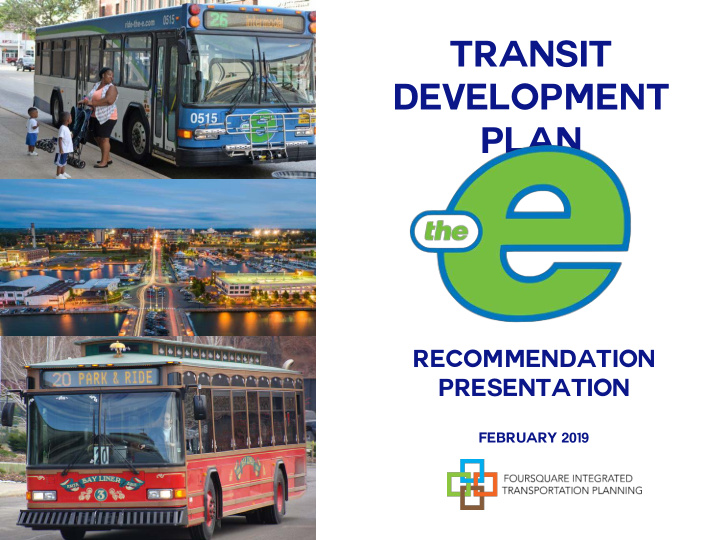



Transit Development Plan Recommendation Presentation February 2019
Project Background EMTA ridership has declined in recent years, as the city continues its transformation from an industrial and manufacturing hub, to a smaller, but more diversified economy led by health care, tourism, insurance, and higher education. The purpose of this study is to assess how well EMTA’s existing network aligns with the transit needs and transit potential of the changing region. 2
Study Goals Identify existing system’s strengths, weaknesses, and opportunities – Review travel patterns – Assess system efficiency – Identify unmet transit needs Recommend service improvements – Serve existing riders better – Attract new riders – Improve over-all system productivity 3
Study Approach 4
Market Analysis 5
Service Analysis 6
Stakeholder Outreach 7
Service Redesign - Guiding Principles Service Should be Simple: − For people to use transit, service should be designed so that it is easy to use and intuitive to understand Service Should Operate at Regular Intervals: − In general, people can easily remember repeating patterns, but have difficulty remembering irregular sequences. Routes Should Operate Along a Direct Path: − The fewer directional changes a route makes, the easier it is to understand. Circuitous alignments are disorienting and difficult to remember. Routes Should be Symmetrical: − Routes should operate along the same alignment in both directions to make it easy for riders to know how to get back to where they came from. Routes Should Serve Well Defined Markets: − The purpose of a route should be clear, and each should include strong anchors and a mix of origins and destinations. Service Should be Well Coordinated: − At major transfer locations, schedules should be coordinated to the greatest extent possible to minimize connection times for the predominant transfer flows. 8
Service Redesign - Preliminary Scenarios Two Scenarios: – Scenario 1: “Maximize Downtown Access” – Scenario 2: “Maximize Cross-Town Connections” 9
10
11
12
13
Service Redesign - Preliminary Scenarios Public Reaction: – 37 surveys submitted online and at public meetings in September 2018 • 11 preferred Scenario 1 • 11 preferred Scenario 2 • 9 preferred current service design • 6 gave no preference 14
Service Redesign - Preliminary Scenarios Public Reaction: – Most “no-change” comments referenced regional routes (12, 14, 105, 229) – Example comments: • “Route 12 needs a stop at the mall. Many riders need that stop being one of their main stops.” • “Route 14 ceasing service downtown via Peach Street would eliminate one-seat rides for users.” • “Both scenarios jeopardize the Corry Loop that is essential and used by many of our community who have no other way to get where they need to go.” 15
Service Redesign - Preliminary Scenarios Recommended Scenarios: – Restructured “Core” Network • Fast and frequent spine service along State and Peach Street (highest-ridership corridor) – 20-minute peak frequency / 30-minute off peak – Links downtown to Peach Street retail destinations • Enhanced cross-town service – Multiple connection opportunities to spine • Simplified circulators – Two Penn State Behrend shuttles – One downtown circulator – Unchanged “Regional Link” Network • Commuter routes (Routes 12, 14, 105, 229) • Community circulators (Routes EE, CL) • Special services (Routes 7, 33) 16
17
18
19
20
21
Transit Development Plan Recommendation Presentation February 2019
Recommend
More recommend